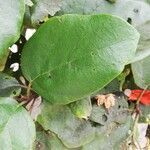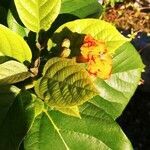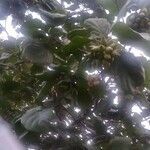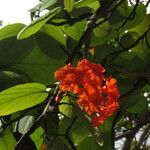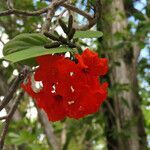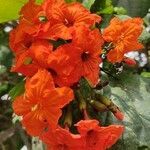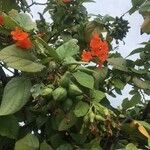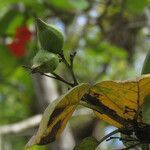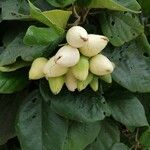Shrubs or trees, the younger stems pubescent. Leaves ovate, sometimes broadly so, acute, entire, the bases ? rounded, to 21 cm long and 15 cm wide, scabrous above, pubescent on the veins beneath; petioles ca 3-4 cm long. Inflorescences cymose, paniculate, loosely-flowered. Flowers perfect, pedicels ca 0.5-1.5 cm long, pubescent; calyx cylindrical, the tube ca 10-12 mm long at anthesis, 3(-4)-lobed, the lobes deltoid and ca 1-2 mm long, greatly enlarging in fruit; corolla funnelform, vermillion, the tube ca 20-25 mm long, 5-6-lobed, the lobes ca 10 mm long and 8-9 mm wide; stamens 5(-6), included, the filaments free from the corolla tube for ca 2-3 mm, ? glabrous at the point of attachment, the anthers ca 2.2-2.4 mm long; ovary ovoid, the style ca 20-25 mm long, the lobes clavate and flattened. Fruit drupaceous, ovoid, hard, ca 2-2.5 cm in diam, the calyx tightly adhering and becoming white and fleshy.
More
An evergreen shrub. It can lose its leaves. It grows up to 10 m high. The leaves are oval and the base is sometimes heart shaped. They are 10-20 cm long. There are teeth on the edge near the tip. The flowers are deep red or orange. They are funnel shaped. The lobes spread out. The fruit are large and creamy white. They are fleshy and 2.5 cm across.
A tropical plant. It grows in tropical America. It is very salt resistant. It needs sandy, well drained soil. It needs full sun. It cannot tolerate cold temperatures. It is damaged by frost. It can tolerate drought. It suits hardiness zones 11-12.
More
Dry districts on sandy soils, often occurring along sea coast at elevations up to 185 metres. Sandy thickets and on limestone rocks in arid coastal areas. Rich hummock soils in Florida.
